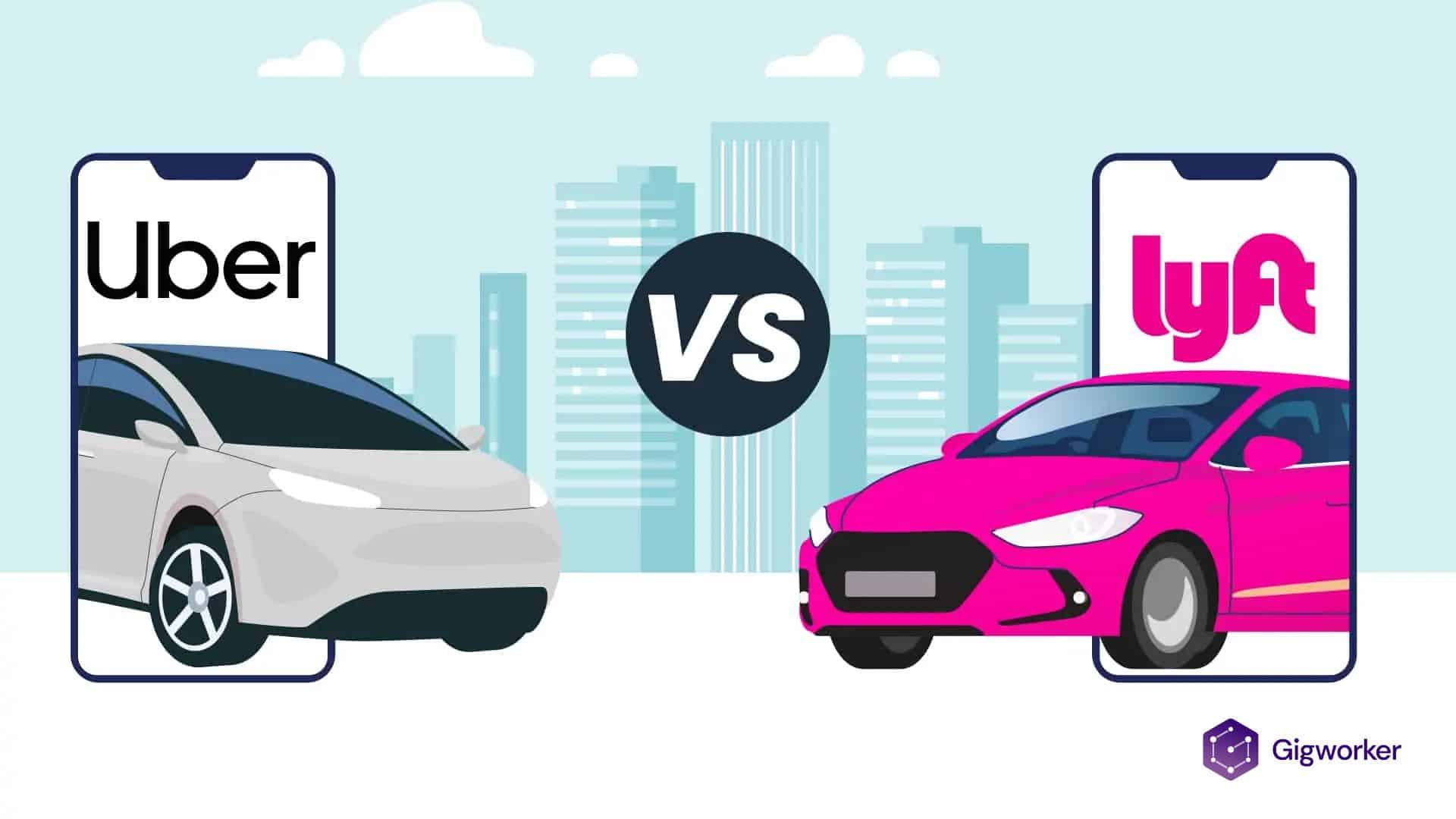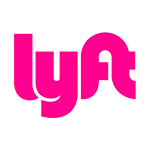Often, the best and easiest way to get where you need to go is to hail a taxi – or these days, a taxi alternative.
Uber and Lyft have been vying for the top spot in the ride-hailing game for over a decade. In a short span of couple of years, these two companies have emerged as two of the strongest brands among ridesharing services.
So which one should you go for?
In this comparison we’re going to look at Uber vs. Lyft, exploring the strengths and weaknesses of both so you can decide for yourself.
We’ll look at each of their:
- Origins and history
- Pricing
- Drivers
- Coverage and offerings
- Sustainability/
So, which is the superior service? Let the battle begin!

What is Lyft?
Lyft is a ride-hailing and transportation app based within the US and parts of Canada. While its roots are in ridesharing, since 2018 it has also launched a bike-sharing system.
What is Uber?
Uber is a similar ride-hailing company. Since its founding in 2009, it has also expanded into a large range of other services, including its popular food delivery known as UberEATS.
A Comprehensive Comparison Between Lyft vs. Uber
A side-to-side comparison of Uber vs. Lyft – the most notable similarities and differences we could find.
| Origins and History | Lyft | Uber |
|---|---|---|
| Origins and History | Founded as Zimride in 2007, launched as Lyft in 2012. | Started as UberCab in 2008, launched rides in 2010. |
| Market Presence | Operates in all US states and most of Canada. | Operates globally, including the US, UK, Mexico, Japan, and more. |
| Pricing | Varies by location and demand. | Pricing varies based on location and demand. |
| Pricing Structure | Base fare, tolls, service fees, surcharges. | Similar pricing structure with local variations. |
| Driver Earnings | Influenced by location, laws, commissions, tipping, and hours worked. | Earnings depend on factors like location and commission. |
| Driver Experiences | Known for a good company culture. | Offers better benefits, but reputation varies. |
| Rider Experience | User-friendly apps, similar driver pool. | Personalized customer support, smaller company. |
| Vehicle Options | Standard, premium, and roomier cars. | More vehicle options, including car-pooling. |
| Other Services | Offers scooters, bikes, and some delivery services. | Has UberEATS and car rental in select areas. |
| Rewards Programs | Lyft Pink offers membership benefits. | Uber Rewards and Uber One provide rewards. |
| Safety Initiatives | Conducts driver background checks, offers safety features. | Prioritizes safety with background checks and features. |
| Company Reputation | Fewer scandals compared to Uber. | Faced various controversies and allegations. |
| Expansion and Initiatives | Supports healthcare, disaster relief, and eco-friendly efforts. | Focuses on healthcare, community, and sustainability. |
| Gigworker’s Pick? | Yes, when you are looking for a great experience. Can oftentimes be cheaper than Uber in times of high demand. | Yes, when you are looking for a reliable, quick ride. There are usually far more Uber vehicles available than Lyft, especially in smaller cities. |
Company Origins and History
Uber
Uber began its life as UberCab in 2008. It was conceived of by Garrett Camp and Travis Kalanick, two entrepreneurs then based in San Francisco.
Uber began to offer rides in 2010. They originally catered to professionals with an exclusively black fleet. Despite being more expensive than a traditional taxi, it quickly gained popularity. Their growth enabled them to offer their services overseas by 2013.
Lyft
Lyft, first conceived in 2007, is self-proclaimed ‘The very first peer-to-peer ride-sharing community’. Similarly, it also began life with another name – Zimride. Originally, it offered long-distance ride-sharing.
By 2012, Lyft as we know it launched in San Francisco, offering short-distance ride-hailing. They gained quick recognition due to their giant pink mustaches that drivers would attach to the front of their cars.
Within the next two years, Lyft expanded outside of San Francisco, and by 2017 they were serving over 1 million rides a day.
Market Presence and Coverage
Lyft operates in every state of the country and offers full coverage in most. You can check here to see if your city is included. You can call a Lyft in 12 Canadian cities, too.
Uber also has coverage all over the US and throughout Canada. Impressively, it’s also present in a large number of other countries – including the UK, Mexico, Japan, and New Zealand.
Pricing and Cost to Riders
Comparing pricing is tricky. For both companies, fares vary wildly between cities.
The best way to compare is likely to do a little detective work – download both apps and see how the fares stack up in your city.
Pricing structure
Both companies run on a similar pricing structure. Though – again – this varies from city to city. However, here’s a breakdown to show you what is generally included in the cost of your ride:
- A base price, typically determined via GPS information (ie, the distance and estimated time of your trip)
- Any tolls or third-party fees along your route
- A service fee (based on your city or region)
- And potentially a surcharge for busy or high-demand periods
Driver Experiences and Earnings
Driver Earnings
How much a driver earns on either app depends on several factors, including (but not limited to):
- Location and app popularity
- State laws
- Commissions
- Tipping culture
- How long they work
As you can see, earnings are a complex issue. They’re made even more difficult when you factor in additional elements such as driver benefits and rewards and the ride modes offered on each platform.
For example, while on average Uber is assumed to pay more to their drivers, they also take a larger commission. And how often your driver decides to get paid will also make a difference.
At the end of the day, both apps pay their drivers a similar amount. However, as part of the ‘gig economy,’ most drivers don’t get paid enough as a standard rule.
Driver Experiences
Millennial Money has a fantastic breakdown of the complex benefits of each company. Overall, Uber offers potentially better benefits, but Lyft has a better company culture.
Rider Experience and App Usability
Rider experience
While each company has strict rules and guidelines for drivers, everyone is human. You are likely to have a slightly different experience every time. And, you’re likely to see the same drivers working for both companies.
Overall, the biggest difference here is likely to come down to customer support – Lyft is smaller and you’re likely to have a more personal experience if you need to contact them.
App usability
Both companies offer easy-to-use apps. Key features of both include:
- A map to show you the identified route
- Safety identification features
- A range of ride options to choose from
In the past, Lyft’s app has been noted to have a few more bugs. However, overall they work similarly well and each is constantly going through updates.
Vehicle Options and Special Services

Vehicle Options
Vehicle options are dependent on the city, but overall both Uber and Lyft offer a range of services. Services they both include are:
- Standard (Lyft and UberX)
- Premium cars (Lyft Lux and Uber Premier)
- Roomier Cars (Lyft Preferred Mode and Uber Comfort)
Generally, Uber has a larger number of vehicle options. These include car-pooling services, an electric vehicle category, and a category for wheelchair-accessible vehicles (in some cities).
Other offerings from Lyft include Wait & Save (a budget-friendly service where you schedule a ride) and Priority Pickup.
Other Services
Both companies also offer other services. Both offer scooters and bikes in some cities. Additionally, both companies have also offered person-to-person delivery services in some areas.
Uber also has a host of other offerings – most notably UberEATS.
They also have a car rental service in some areas.
Rewards Programs
In some areas, Uber offers Uber Rewards – a tier-based rewards program that works over Uber and Uber Eats.
They also offer Uber One, a $9.99 monthly membership subscription to get benefits, such as reduced fees and credit rewards. It also includes $0 delivery fees on Uber Eats and special ride pricing.
Lyft offers its own $9.99 membership subscription (or $99 a year) on its service Lyft Pink. Benefits include free priority pickup, discounts on several ride types (including standard), a year of free Grubhub deliveries, and more.
As you can see, their membership options offer almost exactly the same perks for the same price!
Safety Initiatives and Protocols
Background checks
Both Uber and Lyft require background screening for drivers prior to approval to become drivers. Lyft also requires annual background checks for all drivers.
Other safety strategies
On both apps, you will be able to see the make and model of your driver’s car as well as their license plate to make sure you’re in the right hands.
My favorite safety feature is that you can select your favorite contacts and allow them to see where you are at all times during your ride!
Both companies also claim to hide your details – including your phone numbers. Lyft also claims to hide your trip history afterward, so no one can check where you’ve been from a driver’s phone.
Lyft also claims to have a smart system that monitors any suspicious GPS activity and checks in if they find anything odd.
Emergency Services
Last but not least, you can call emergency services straight from each app. Lyft allows you to go to ADT for help from humans 24/7, or go silently straight to 911.
Company Reputation and Controversies
In this category, Lyft wins hands-down.
Uber has had its share of controversies, including (but not limited to) a year, when it was hacked (with 57 million accounts breached), kept the breach a secret, and had a past employee accuse the company of having ‘a culture of sexual harassment’.
Lyft, on the other hand, has very few scandals. However, as two large drivers of the gig economy, both companies are under constant scrutiny for potentially exploiting and underpaying workers.
Expansion and Diversification
Environmental and Community Initiatives
Community Initiatives
Uber’s reported community initiatives in 2023 focused on healthy communities. They provided access to health appointments for those who needed it across the US. They also have started grants and a community access fund to provide transport for those in need.
Lyft’s 2022 statistics also have an emphasis on healthcare and mobilization. They also emphasize supporting a diverse set of businesses, voting access, and job access.
Both companies have also supplied disaster relief across the US, after a range of natural disasters.
Environmental impacts
Arguably, both companies are assisting a brighter future where there are less cars per person on the road, making for a healthier environment and community.
Both companies have a larger percentage of their fleets as electric or hybrid cars, and promote further uptake of green vehicles. Uber has its sights set on their entire fleet being electric in a few decades.
Both also promote the use of shared bikes and scooters as more environmentally sustainable modes of transport.
Lyft also champions the use of public transport and is integrating timetables into its app in several major cities.
The Verdict on Lyft vs. Uber: What’s Better?
Which company is best may depend largely on which city you live in. The numbers of drivers may vary wildly per city, and due to unpredictable pricing structures across the country – it’s always best for you to check!
However, if you’re looking for the largest range of options, Uber might be your best bet. They have the largest range of ride options – and you can’t forget Uber Eats!
On the flip side, if you’re concerned about the social impacts of each company, Lyft is generally more transparent and has fewer scandals in its books. They also emphasize creating a well-rounded strategy to support small businesses and sustainable transport.
Frequently Asked Questions

Is Uber better than Lyft?
Uber has a larger range of ride-hailing options than Lyft, including wheelchair-accessible vehicles and ride-sharing. However, both companies offer a good range of services and often share the same drivers.
Why is Lyft cheaper than Uber?
Prices for both companies vary per city, so it could be cheaper for a range of reasons. Overall, Lyft takes less of a commission from drivers than Uber (and may also pay less), which may allow them to keep prices down.
How does Lyft differ from Uber?
Lyft offers most of the same core services as Uber, including standard and premium rides. The biggest difference is that Lyft does not offer a food delivery service. Instead, they have teamed up with Grubhub for Lyft Pink members.
Sources
The sources we reviewed to write this article.
View All
- https://www.lyft.com/
- https://drive.google.com/file/d/18q4IA45txNQCMRDKrrB5lL15HWRoXlnS/view
- https://www.britannica.com/topic/Uber
- https://www.youtube.com/watch?v=TVpbQLXEpMc
- https://edition.cnn.com/interactive/2019/03/business/lyft-history/index.html
- https://www.lyft.com/rider/cities
- https://www.uber.com/global/en/cities/
- https://millennialmoney.com/uber-vs-lyft/
- https://www.nytimes.com/2019/04/17/technology/personaltech/uber-vs-lyft.html#:~:text=While%20both%20services%20look%20identical,receipts%20could%20leave%20people%20perplexed.
- https://www.nytimes.com/2017/02/25/technology/farhads-and-brians-week-in-tech-ubers-very-bad-month.html
- https://www.uber.com/us/en/u/uber-one/
- https://www.lyft.com/memberships/lyft-pink-monthly/offer-details?offer_id=lyft-pink-monthly&utm_campaign=pink_22q2_salespage_redirect&utm_medium=referral&utm_source=blog
- https://s23.q4cdn.com/407969754/files/doc_downloads/2023/04/Uber-2023-Environmental-Social-and-Governance-Report.pdf?uclick_id=e8b7faa1-4f9e-4d5f-84bc-6cf7a232ceba
- https://s27.q4cdn.com/263799617/files/doc_downloads/2022/ESG-2022-Report_Final.pdf







